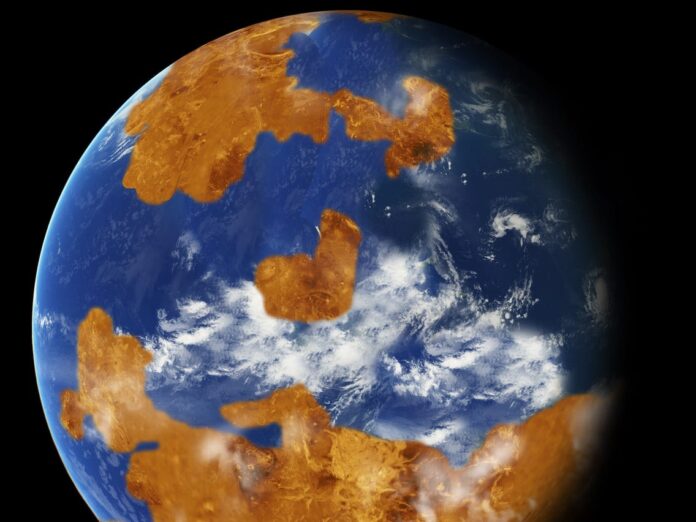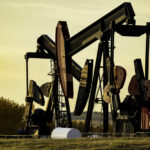Venus is an oddball planet that is roughly the same size as Earth and lies in what would normally be considered the habitability zone for our Sun. But far from being inhabitable, the planet’s surface temperatures reach 450 Celsius (842 Fahrenheit) degrees. Its atmosphere is 96% carbon dioxide, and at ground level is 90 times greater in density than sea level here on Earth. On top of this Venus has a retrograde rotation making every day longer than the annual trip the planet takes around the Sun which takes 224 Earth days. On Venus, when the Sun rises which is seldom, it comes up in the west and sets in the east. It is a hellishly long day in what can only be described as a hellish place upon which to live.
What could have happened to make this reality? According to the latest scientific theories and astronomic observations, Venus, one billion Earth-years ago wasn’t like what I have described in the previous paragraph. Its climate at the surface was more Earth-like. See the above picture. That’s how NASA scientists depict Venus back then, a planet with oceans, lakes, rivers, and continents. A planet with plate tectonic forces similar to Earth. It likely had life. Its axial rotation would also have been different, more Earthlike in terms of timing with daily cycles that allowed for heating and cooling at the surface.
But something happened around a billion years ago. In using radar imaging from the NASA Magellan 1990s mission, scientists have been able to identify geomorphology that largely supports the picture of a more Earth-like world interspersed among volcanic rocks that suggest massive eruptive forces, what we would define here on Earth as mega eruptions.
Earth history has a record of mega eruptions with similar characteristics. In fact, there have been at least 15 in the past three billion years, many coincident with mass extinction events. These include two, more well known, the Siberian and Deccan Traps, the former which occurred 272 million years ago and the latter 66 million years ago. During the Siberian event greenhouse gas emissions would have altered Earth’s atmospheric temperature and ocean chemistry in a geological blink of an eye. A recent study suggests at the height of the Siberian Traps, global temperatures would have risen by as much as 7 Celsius (12.6 Fahrenheit). Does the Siberian Traps mega eruption coincide with a mass extinction? Not quite. It’s off by about 20 million years from the Permian extinction event which is more than a rounding error even in gelogic time.
The Deccan Traps, on the other hand, suspiciously coincides with the Cretaceous-Tertiary event associated with the demise of the dinosaurs. The Deccan mega eruption is a counterweight to the commonly held view of an asteroid strike being the cause.
On Venus, the mega eruptions appear to dwarf those from our geologic record. Evidence from Magellan imagery shows magma flows measuing more than 7,000 kilometers (more than 4,300 miles). Could these mega eruptions not only have altered the atmosphere but exerted enough force as well to slow the planet’s rotation and even reverse it?
Certainly, the eruptions on Venus would have contributed massive volumes of heat-trapping gases like the carbon dioxide in evidence today. This would explain a runaway greenhouse effect. It could also explain changes to axial rotation. With a larger atmospheric volume solar tidal forces could cause axial rotation drag. Would the force be enough to cause Venus to eventually develop a retrograde rotation?
All planets in our Solar System with the exception of Venus spin in the same direction. The only other oddball is Uranus which appears to have been knocked on its side 90 degrees from vertical so it resembles a spinning bowling ball careening down a lane as it orbits the Sun.
But getting back to Venus, could the accumulation of a number of mega eruptions a billion years ago not lead to rotational drag but instead cause the planet to flip upside down which could explain why its rotation appears opposite to that of the Earth and other Solar System planets? If that were true then Venus’ axial rotation isn’t really in reverse at all. It’s just terribly slow which could be explained by solar tidal forces or the proximity of Mercury exerting its own influence.
I raise a possible explanation not mentioned in the prevailing literature. Could Venus have been struck by a large space object that could explain both the mega eruptions and the retrograde orbit? For example, an Earth moon-sized impactor would certainly alter the planet’s environment and rotational dynamics, particularly if the object impacted from a direction opposite Venus’ spin. But where would we find the evidence for such an impact? It’s difficult on Venus because much of the planet’s scarring would be buried under the mega eruptions that are visible by radar today.
Other potential evidence of an impactor would be the presence of one or more rings around Venus containing ejected debris from the impact. The absence of ring material may be explained by the close proximity to the Sun’s gravitational force which could dissipate planet-circling debris over a billion years. That’s not the case for the outer planets of the Solar System which feature ring systems today. The Sun’s tidal forces are greatly diminished by distance.
Another thought. Maybe all planets close to their parent star through solar tidal forces lose axial spin. Could that explain the current rotation of Venus? Looking to Venus’ other neighbour, Mercury, we should see evidence to corroborate this theory. In one respect it does. Mercury’s rotation rate is extremely slow when compared to Earth, Mars, or any of the outer planets. Mercury rotates on its axis three times during an annual passage around the Sun and it rotates in the same direction as all the other planets.
So Venus remains quite the mystery. Each time I look at it as the brightest object other than the Moon in the early evening or morning sky, I imagine what it would have been like to observe the planet from Earth a billion years ago. Our nearest neighbour back then would have been a benign environment for evolutionary forces to do their work. What kind of life would have flourished there before the forces of nature and time altered it to make it what it is today?
















